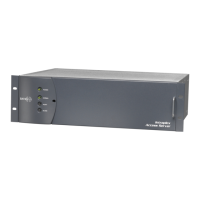ACS-160 Series & STL-160 Series T1 Mux Installation & Operation 6-Testing & Troubleshooting
Version 2.11, August 2011
6-14 Harris Corporation
Intraplex Products
The two equipment jacks are used for out-of-service testing. When you insert a plug into the
Equipment In jack, the incoming T1 signal from the MA-215 module is disconnected from the T1
receiver on the CM-5RB module and a signal can be injected at this point to the CM-5RB module.
Similarly, when a plug is inserted into the NETWK OUT jack, the output of the CM-5RB T1 transmitter
is disconnected from the MA-215 module and a signal can be injected at this point to the network.
The two MON jacks are designed for in-service testing and are therefore equipped with isolation
amplifiers. Because of these amplifiers, the T1 signals received and transmitted by the multiplexer can
be monitored without affecting their levels.
6.5.2 T1 Test Equipment Use with In-Service Tests
6.5.2.1 In-service Monitoring Procedure
When intermittent errors occur on one or more data channels, it is often helpful to perform in-service
monitoring on the T1 facility. This monitoring primarily helps determine whether the channel errors
are caused by errors on the T1 facility rather than by a fault in the channel module or in another
section of the low-speed circuit. Use this procedure to perform in-service monitoring of a T1 facility
between two ACS-160 locations (Figure 6-6), which does not affect any of the channel traffic between
these locations.
1. To measure performance in the Location 2 to Location 1 direction, connect the DS1/T1 input of a
T1 test set to the T1 IN MON jack on the multiplexer at Location 1.
2. To measure performance in the Location 1 to Location 2 direction, connect the DS1/T1 input of a
T1 test set to the T1 IN MON jack on the multiplexer at Location 2.
Figure 6-6. T1 Circuit In-Service Monitoring
6.5.2.2 Test Result Interpretation Guidelines
● On T1 systems using the ESF frame format, measure total CRC-6 errors, CRC-6 errored seconds,
and CRC-6 severely errored seconds to determine overall facility performance.
● Check the CM-5RB CSU statistics (Section 5.2.3.10) for cyclic redundancy check (CRC) error
events or other error conditions.
● On systems using the SF frame format, frame bit error counts can be used to detect the presence
of a high bit error rate or a severe error burst. However, frame bit error monitoring cannot usually
identify problems causing very low error rates.
● Check with your service provider to determine what level of error performance is guaranteed on
your T1 circuit. Compare that level with your actual test results.

